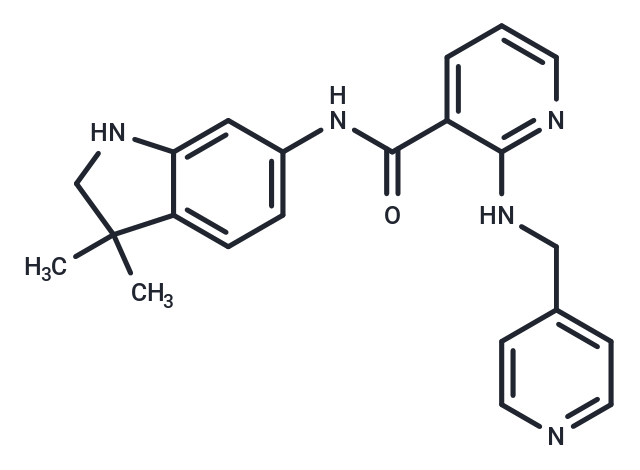Shopping Cart
- Remove All
 Your shopping cart is currently empty
Your shopping cart is currently empty

Motesanib (AMG 706) is an orally bioavailable receptor tyrosine kinase inhibitor with potential antineoplastic activity. AMG 706 selectively targets and inhibits vascular endothelial growth factor (VEGFR), platelet-derived growth factor (PDGFR), Kit, and Ret receptors, thereby inhibiting angiogenesis and cellular proliferation.

| Pack Size | Price | Availability | Quantity |
|---|---|---|---|
| 5 mg | $37 | In Stock | |
| 10 mg | $54 | In Stock | |
| 50 mg | $174 | In Stock | |
| 1 mL x 10 mM (in DMSO) | $58 | In Stock |
| Description | Motesanib (AMG 706) is an orally bioavailable receptor tyrosine kinase inhibitor with potential antineoplastic activity. AMG 706 selectively targets and inhibits vascular endothelial growth factor (VEGFR), platelet-derived growth factor (PDGFR), Kit, and Ret receptors, thereby inhibiting angiogenesis and cellular proliferation. |
| Targets&IC50 | c-Kit:8 nM, VEGFR1:2 nM, VEGFR3:6 nM, VEGFR2:3 nM |
| In vitro | Motesanib exhibits extensive efficacy against the VEGFR family in humans, with more than 1000-fold selectivity over EGFR, Src, and p38 kinase. It notably reduces VEGF-triggered proliferation in HUVECs, achieving an IC50 of 10 nM, but demonstrates minimal influence on bFGF-driven proliferation, with an IC50 exceeding 3,000 nM. Furthermore, Motesanib effectively hinders PDGF-stimulated proliferation and SCF-induced c-kit phosphorylation, presenting IC50 values of 207 nM and 37 nM, respectively. However, it lacks efficacy against EGF-induced EGFR phosphorylation and the viability of A431 cells. While having limited antiproliferative effects on HUVECs growth on its own, Motesanib markedly enhances the sensitivity of these cells to fractionated radiation. |
| In vivo | Motesanib, at a dose of 100 mg/kg, significantly reduces VEGF-induced vascular permeability in a time-dependent manner. When administered orally once or twice daily, it effectively suppresses VEGF-induced angiogenesis in the rat corneal model, with ED50 values of 4.9 mg/kg and 2.1 mg/kg, respectively. Furthermore, Motesanib promotes dose-dependent regression of established A431 xenografts by targeting tumor cell neovascularization. In combination with radiation, it demonstrates pronounced anti-tumor efficacy in head and neck squamous cell carcinoma (HNSCC) xenograft models. Additionally, Motesanib alone, or when combined with docetaxel or tamoxifen, significantly curtails tumor growth and blood vessel density in MCF-7, MDA-MB-231, or Cal-51 xenografts in a dose-dependent manner. |
| Kinase Assay | Optimal enzyme, ATP, and substrate (gastrin peptide) concentrations are established for each enzyme using homogeneous time-resolved fluorescence (HTRF) assays. Motesanib is tested in a 10-point dose-response curve for each enzyme using an ATP concentration of two-thirds Km?for each. Most assays consist of enzyme mixed with kinase reaction buffer [20 mM Tris-HCl (pH 7.5), 10 mM MgCl2, 5 mM MnCl2, 100 mM NaCl, 1.5 mM EGTA]. A final concentration of 1 mM DTT, 0.2 mM NaVO4, and 20 μg/mL BSA is added before each assay. For all assays, 5.75 mg/mL streptavidin-allophycocyanin and 0.1125 nM Eu-PT66 are added immediately before the HTRF reaction. Plates are incubated for 30 minutes at room temperature and read on a Discovery instrument. IC50 values are calculated using the Levenberg-Marquardt algorithm into a four-parameter logistic equation. |
| Cell Research | Cells are preincubated for 2 hours with different concentrations of Motesanib, and exposed with 50 ng/mL VEGF or 20 ng/mL bFGF for an additional 72 hours. Cells are washed twice with DPBS, and plates are frozen at -70°C for 24 hours. Proliferation is assessed by the addition of CyQuant dye, and plates are read on a Victor 1420 workstation. IC50 data are calculated using the Levenberg-Marquardt algorithm into a four-parameter logistic equatio. |
| Alias | AMG 706 |
| Molecular Weight | 373.45 |
| Formula | C22H23N5O |
| Cas No. | 453562-69-1 |
| Smiles | CC1(C)CNc2cc(NC(=O)c3cccnc3NCc3ccncc3)ccc12 |
| Relative Density. | 1.251 g/cm3 |
| Storage | Powder: -20°C for 3 years | In solvent: -80°C for 1 year | Shipping with blue ice. | |||||||||||||||||||||||||||||||||||
| Solubility Information | DMSO: 50 mg/mL (133.89 mM), Sonication is recommended. | |||||||||||||||||||||||||||||||||||
Solution Preparation Table | ||||||||||||||||||||||||||||||||||||
DMSO
| ||||||||||||||||||||||||||||||||||||

Copyright © 2015-2025 TargetMol Chemicals Inc. All Rights Reserved.